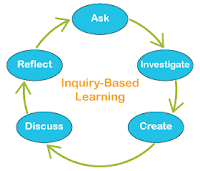There is an old saying: Tell me and I forget. Show me and
I remember. Involve me and I understand. Inquiry-based learning enables
students to become involved in their learning for better understanding. When
using inquiry-based learning, the teacher acts as a facilitator rather that a
purveyor of information. This type of learning is more engaging and exciting
for students than traditional methods. Bright kids really enjoy it because they
are asked to question, to investigate, and to experiment, all while using
critical thinking skills.
There are quite a few websites that explain how
inquiry-based learning works and offer sample lesson plans for students K-12.
- Intro to Inquiry Learning has two particularly helpful sections: “Advantages of Inquiry-Based Learning” and “The Art of the Question.” This second section explains how to ask good questions, which may be more complicated and sophisticated than many parents and teachers realize.
- Workshop: Inquiry-Based Learning offers all the basics of inquiry-based learning, provides classroom demonstrations through video clips, explains how to get started, and shows how to create a facilitation plan. (Be sure to click through the tabs at the top of the page.)
- Inquiry Page lets you looks at actual units using inquiry-based learning.
Consider using inquiry-based learning both at school and at
home. Students will be actively engaged while improving their critical and
creative thinking skills.

No comments:
Post a Comment
Your comments will be available after approval.